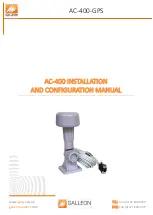
Coastal 18 Ku-Band TVRO
Operation
2-3
6
Search Wait
- Indicates that a signal has been detected and the antenna is peaking the signal
level.
7
NID HHHH EL ##
- Will be displayed whenever a satellite signal is found. This message is
comprised of Network ID and the Elevation for the satellite being targeted or which satellite has
been found.
HHHH
is the 4 digit HEX value of the Network ID reported by the Satellite
Identification Receiver in the PCU. If satellite information has been previously saved and
matches the satellite found, the system will immediately go into TRACKING mode and display
this information. If this is NOT the desired satellite the system will continue searching by
displaying “Search Next UP” or “Search Next DN”.
8
Search Next UP
- Will be displayed whenever the system conducts a search for the next
satellite UP (CW/Right) from the satellite location it was previously at. This search may be
initiated automatically or when the operator presses the NEXT key.
9
Search Next DN
- Will be displayed whenever the system conducts a search for the next
satellite DOWN (CCW/Left) from the satellite location it was previously at. This search may be
initiated automatically or when the operator presses the NEXT key.
2.2.3. Tracking phase
Sat1 DTV101 1876
NID FFFE EL 45
2
First line of the TRACKING display will be the information for the satellite which is currently being tracked.
In the display example above, the system is tracking the Sat1 satellite selection, named DTV101
(DirecTV at 101W) with a signal strength of 1876 counts of AGC.
Second line of the TRACKING display is the NID currently being received (FFFE) and the current
Elevation angle of the antenna (45 degrees).
This display indicates that the system has now entered into OPERATION mode. TRACKING LED is ON.
2.3. Operation Mode Scenerios
Below are some common examples of operating the system when Sat1, Sat2, Sat3, Sat4, Sat5 and Sat6
information has been saved. You can also refer to the Operation Flow Chart. If satellites have not been
previously saved, refer to Section 5 – Initial Setup.
2.3.1. Switching Satellites
Press NEXT to switch to the next (numerically) satellite.
2.3.2. Adjusting Polarization
Polarization adjustment is NOT required when you are outfitted for circular satellite usage.
If you have a Linear LNB installed, you will have to manually adjust the polarization. Manual adjustment
will be required whenever the boat has traveled about 10 degrees of latitude or longitude from where you
last adjusted the linear polarization.
Summary of Contents for COASTAL 18
Page 3: ......
Page 8: ...Table of Contents viii This Page Intentionally Left Blank ...
Page 30: ...Installation Coastal 18 Ku Band TVRO 4 8 This Page Intentionally Left Blank ...
Page 42: ...Setup Coastal 18 Ku Band TVRO 5 12 Figure 5 3 Display Antenna Control Panel Setup Mode page 1 ...
Page 43: ...Coastal 18 Ku Band TVRO Setup 5 13 Figure 5 4 Display Antenna Control Panel Setup Mode page 2 ...
Page 44: ...Setup Coastal 18 Ku Band TVRO 5 14 Figure 5 5 Display Antenna Control Panel Setup Mode page 3 ...
Page 45: ...Coastal 18 Ku Band TVRO Setup 5 15 Figure 5 6 Display Antenna Control Panel Setup Mode page 4 ...
Page 46: ...Setup Coastal 18 Ku Band TVRO 5 16 Figure 5 7 Display Antenna Control Panel Setup Mode page 5 ...
Page 54: ...Maintenance Coastal 18 Ku Band TVRO 6 8 This Page Intentionally Left Blank ...
Page 60: ......
Page 64: ...Computer Interface Coastal 18 Ku Band TVRO 8 4 This page left blank intentionally ...
Page 66: ...Drawings Coastal 18 Ku Band TVRO 9 2 This page left blank intentionally ...
Page 75: ......
Page 76: ......
Page 77: ......














































